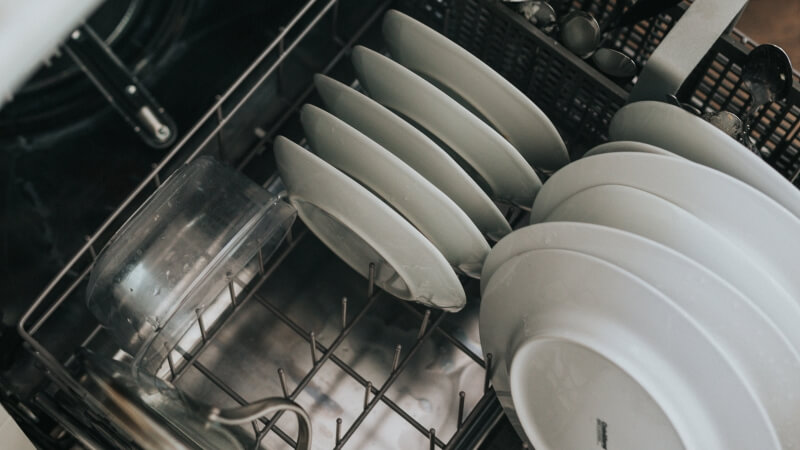
Gym Essentials For Women:A Complete List
Enthusiasts who never miss a session, understanding the gym essentials for women is crucial, not just for what to wear but also for what to

Is stainless steel dishwasher safe? Stainless steel is one of the most popular materials for a wide range of household items, with its primary use found in kitchen appliances and accessories.
Many people are drawn to stainless steel due to its timeless aesthetic appeal, making it suitable for any era. However, the true value of stainless steel lies in its exceptional properties that make it the ideal choice for numerous home items.
One such property is its ease of sterilization, making stainless steel the top choice in commercial kitchens and a staple in family homes.
Additionally, stainless steel is resistant to stains and possesses anti-corrosive properties, ensuring that it maintains a new-like appearance as long as it is well-maintained. With its durability, many have made the switch from single-use plastic to stainless steel in recent years.
However, when it comes to dishwasher safety, it’s important to delve into what stainless steel is made of and its composition.
Stainless steel is a remarkable alloy of iron, distinguished by its minimum Chromium content of 10.5%. Chromium, a pivotal chemical element in this alloy, plays a crucial role in forming a thin oxide layer on the steel’s surface, aptly known as the passive layer. This passive layer serves as a formidable shield against further corrosion.
While 10.5% is the minimum Chromium requirement, top-quality stainless steel often boasts higher Chromium content, enhancing its resistance to corrosion. In addition to Chromium, stainless steel compositions may encompass varying levels of Manganese, Silicon, and Carbon.
Notably, some stainless steel formulations incorporate Nickel, contributing to the alloy’s characteristic silver luster and providing an additional layer of rust resistance.
On certain stainless steel products, such as silverware, you may encounter a stamp denoting something like ’18/8.’ This marking reveals the quantity of Chromium on the left and Nickel on the right.
Generally, the higher these numbers, the superior the quality of the stainless steel. Understanding the composition of stainless steel is pivotal in evaluating its performance and durability.
In a nutshell, stainless steel is typically considered dishwasher safe. However, it’s essential to note that employing the dishwasher for these items does entail certain risks.
To offer you a clearer perspective and aid in your decision-making process, let’s delve into the potential hazards associated with placing some of the commonly used stainless steel items in your dishwasher.
Most people will probably already put their stainless steel silverware in the dishwasher, and the good news is that this is perfectly safe.
It is advised that you use the silverware basket provided with most dishwashers in order to separate silverware out as this avoids mixing with other materials that could cause stainless steel to erode.
You should also rinse the silverware off before placing it in the dishwasher to avoid prolonging its exposure to acidic foods, especially if you aren’t planning to run it immediately.
Some people may experience rust spots on their stainless steel knives after some time, but this isn’t anything to worry about, and the same thing would be likely to happen if you hand-washed them.
The reason this happens is because the blades are often made out of a harder steel that remains sharp, but rusts more easily.
Drying them immediately after a dishwasher load finishes may help delay the onset, but using a stainless steel cleaner will make them look as good as new if you forget.
The question of whether stainless steel pots and pans are dishwasher safe sparks a bit of controversy, but the prevailing opinion, especially among manufacturers, leans towards caution.
Many manufacturers caution against dishwasher use, citing the potentially harsh nature of dishwasher detergents, which can lead to corrosion of the stainless steel surface.
In contrast, some dishwasher detergent labels counter this claim, while others deem the manufacturer’s warnings as overly cautious.
Reports from users vary, with some unfortunate side effects mentioned, such as stubborn watermarks that prove challenging to remove.
Generally, it’s accepted that using a dishwasher for stainless steel cookware can gradually dull their appearance, resulting in stubborn spots and discoloration that may prove challenging to rectify.
To maintain the pristine condition of your stainless steel pots and pans, it’s advisable to opt for hand washing and immediate drying. The exception lies with cookware explicitly labeled as dishwasher safe, as these have undergone thorough testing to ensure their compatibility with dishwasher use.
While stainless steel kitchen utensils like fish slicers, spatulas, serving spoons, and whisks may not be the most common choice, they are indeed available in the market.
Often, these utensils are casually grouped with silverware, and many assume they are dishwasher-safe without a second thought. However, this might not be the best practice.
The issue lies not so much with the utensil mechanisms themselves, which are generally robust, but rather with the handles. Many of these handles are crafted from plastic, and even those made of stainless steel tend to be hollow.
This hollowness presents a challenge in terms of cleaning and offers a prime opportunity for dishwasher detergent to seep in and gradually corrode the material from the inside. This corrosion can lead to rust formation, compromising the utensil’s integrity and potentially causing rust-related issues.
To steer clear of these problems, it’s advisable to opt for hand washing these items and to be mindful of wetting only the part of the utensil that was actively used during the cooking process. This will help preserve both the functionality and appearance of your stainless steel kitchen utensils.
Travel mugs have gained popularity in recent years as a sustainable choice to reduce single-use plastic waste.
These handy containers are often associated with convenience, leading one to assume they are designed to be dishwasher safe. However, reality is not quite that simple.
If you possess a stainless steel travel mug that lacks insulation and coloration, it’s likely safe to place it in the dishwasher.
However, the majority of stainless steel travel mugs are insulated, as this feature is key to keeping beverages hot or cold for extended periods.
This holds true for our smart water bottle, which boasts full insulation, capable of maintaining drinks at optimal temperatures for up to 24 hours for cold beverages and 12 hours for hot ones.
While we can not prescribe a specific course of action, it’s essential to be aware of the potential consequences of running stainless steel travel mugs through the dishwasher.
One major concern is the risk of damaging the insulation, rendering the bottle ineffective and necessitating an untimely replacement.
Furthermore, dishwasher use can lead to discoloration in both colored and non-colored stainless steel vessels, and over time, rust may begin to form.
As an alternative, it is generally recommended to rinse your smart water bottle with warm water immediately after use to prevent staining.
Subsequently, a thorough hand wash and prompt drying will keep it in top condition, ready for your next adventure.
While it’s clear that not all stainless steel items are ideally suited for the dishwasher, we understand that it remains a convenient choice for many.
If you’re determined to use the dishwasher despite our cautionary advice, there are steps you can take to minimize potential damage.
First and foremost, consider researching and investing in dishwasher detergent specifically designed for stainless steel or one that contains minimal harmful chemicals. This can go a long way in preserving the integrity of your stainless steel items.
To ensure your stainless steel remains dishwasher safe, always rinse off any food residue from the items before placing them in the dishwasher.
This practice holds particular significance if you don’t plan to run the dishwasher immediately. It helps prevent acidic foods from gradually eroding the stainless steel surfaces over time.
Lastly, a crucial step after each dishwasher cycle is to promptly dry your stainless steel dishes. This prevents water spots and marks from forming, preserving their pristine appearance.
For items like silverware, you might also consider investing in a stainless steel cleaner. Occasional use of such a cleaner can help restore their original shine and luster every few months or as needed.
To address the fundamental question, “Is stainless steel dishwasher safe?” the straightforward answer is yes.
However, as we’ve explored throughout this article, the reality can be more complex. It’s crucial to exercise caution when considering dishwashing your stainless steel items, as it often goes against manufacturer recommendations.
While it may not pose as significant of a concern for smaller items like stainless steel silverware, larger items such as pots and pans are best washed by hand.
When in doubt about the dishwasher safety of a particular stainless steel item, err on the side of caution and opt for hand washing.
For those who choose to disregard these warnings, the tips we’ve provided can help mitigate potential consequences.
Additionally, keep in mind the use of stainless steel polish when you notice a loss of luster, restoring your items to their original brilliance.
By following our guidance, stainless steel proves to be a valuable investment that can endure for several decades when properly cared for. Investing time and effort now can ensure the longevity and beauty of your stainless steel possessions.
Can I put stainless steel silverware in the dishwasher?
Yes, you can safely place stainless steel silverware in the dishwasher. It’s recommended to use the silverware basket provided in most dishwashers to prevent mixing with other materials that might cause corrosion. Rinse the silverware before placing it in the dishwasher to minimize prolonged exposure to acidic foods.
What should I do if I notice rust spots on my stainless steel knives?
Rust spots on stainless steel knives are generally not a cause for concern. These spots can occur, especially on knife blades made of harder steel that remains sharp but is more prone to rust. Drying the knives immediately after a dishwasher cycle and using a stainless steel cleaner can help restore their original shine and appearance.
Are stainless steel pots and pans dishwasher safe?
Most manufacturers caution against using the dishwasher for stainless steel pots and pans due to the potentially harsh nature of dishwasher detergents. While some dishwasher detergents may counter these claims, it’s generally accepted that dishwasher use can dull the appearance of cookware and result in stubborn spots and discoloration. It’s advisable to hand wash and immediately dry pots and pans unless they are explicitly labeled as dishwasher safe.
Can I put stainless steel kitchen utensils in the dishwasher?
While stainless steel kitchen utensils are durable, caution is needed when it comes to their handles. Many handles are made of plastic or hollow stainless steel, making them susceptible to damage from dishwasher detergents. To preserve their functionality and appearance, it’s best to hand wash these utensils and be mindful of wetting only the part used during cooking.
What’s the difference between Stainless Steel 304 and 201?
Stainless Steel 304 and 201 are two common stainless steel alloys, each with distinct properties. Stainless Steel 304 contains a higher percentage of chromium (18%) and nickel (8%) compared to Stainless Steel 201, making it more corrosion-resistant and suitable for a wide range of applications. Stainless Steel 201, on the other hand, contains less nickel and is less corrosion-resistant but can be more cost-effective. The choice between them depends on specific usage requirements and budget considerations.


Enthusiasts who never miss a session, understanding the gym essentials for women is crucial, not just for what to wear but also for what to

A common myth circulating in the fitness world is the belief that a gym diet plan is unnecessary. Many seem convinced that they can simply

The average bench press, often referred to humorously in gyms as ‘How much ya bench’ or ‘whaddaya bench?’, stands as a quintessential measure of strength

Nowadays, we always seem to be packing a bag for something. Whether it’s getting ready for work with your messenger bag or briefcase, filling up

Enthusiasts who never miss a session, understanding the gym essentials for women is crucial, not just for what to wear but also for what to

A common myth circulating in the fitness world is the belief that a gym diet plan is unnecessary. Many seem convinced that they can simply

The average bench press, often referred to humorously in gyms as ‘How much ya bench’ or ‘whaddaya bench?’, stands as a quintessential measure of strength

Nowadays, we always seem to be packing a bag for something. Whether it’s getting ready for work with your messenger bag or briefcase, filling up
Copyright © 2025 remindsmartbottles. All Rights Reserved.
Copy the coupon code below and fill it in when you purchase to enjoy!
newuser